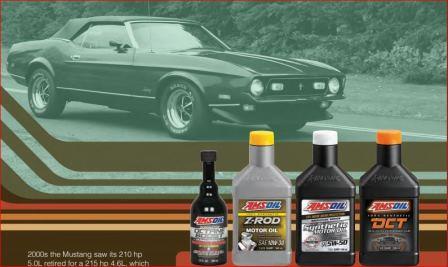MUSCLE CAR MANIA: VOL. 1 Ford Mustang – America’s Pony Car
The Mustang has been one of the most celebrated symbols of Americana for nearly six decades. Appearances in hit movies like “Gone in 60 Seconds,” “Bullitt” and “Goldfinger,” partnerships with racing legends like Carroll Shelby and numerous special editions have all helped set it apart as one of the ultimate enthusiast vehicles. Overall, it’s been one of Ford’s most successful models.
Our Muscle Car Mania series highlights some of the most iconic muscle cars in history. First up: the Ford* Mustang.*
The Kick-Off
The Ford Mustang debuted April 17, 1964 at the World’s Fair at an affordable starting price of $2,368. The model established a new variety of sporty, compact automobiles, fittingly known as pony cars, with strength and power that could garner respect on the track and the street. With its wide range of interior, exterior and powertrain options, the car appealed to many different lifestyles and quickly became a crowd favorite. In fact, Ford sold almost 7 times more than the company had originally projected.
The Mustang’s incredible popularity led Ford to start making upgrades even before completing its first model year. Generators were swapped out for alternators, and the higher performance Challenger Special* 289 c.i. V8 (225 hp) and Challenger HiPo* 289 c.i. (271 hp) engine options were added. While all sales were reported as 1965 model sales, most enthusiasts refer to early production models as 1964 1/2 models and 1965 models.
Next In Line
A few short years after its initial launch, the Mustang was fitted with its first big-block 390 in 1967, escalating it to muscle-car status. Several generations of Mustangs rolled out with their own unique features and styles in the late ‘60s and early ‘70s, including the iconic Boss* 302 and Boss 429, featuring the 302 Windsor* engine, and the heart-pounding 429 race-inspired 375 hp V8, which replaced the 390, 427 and 428 big blocks. Ford also started introducing several special- edition Mustang models, including the Bullitt,* the California Special* and the Shelby GT* that dominated auto racing in the late ‘60s.
Rising gasoline prices in the early ‘70s shifted Ford’s focus toward fuel economy rather than performance. The Mustang II generation took a sharp turn from the heavy muscle- car style and instead made lighter models with reduced horsepower to keep in line with government fuel regulations.
The 1970s presented many challenges to the muscle-car market. EPA regulations limiting the use of lead in gasoline, the restriction of tailpipe emissions, an oil embargo and the introduction of import vehicles changed the landscape for a decade. It wasn’t until the mid ‘80s when the Mustang was finally fitted with an upgraded 5.0L that produced a respectable 210 hp. This was also when Ford used a roller cam to allow for the use of traditional passenger-car motor oil rather than the high-zinc oil required by its predecessors.
Mustangs Up To Date
The Mustang continued evolving throughout the years to adapt to changing markets and styles. Throughout the late ‘90s and 2000s the Mustang saw its 210 hp 5.0L retired for a 215 hp 4.6L, which received mild upgrades until it was replaced by the now legendary Coyote* 5.0L, which pumped out a whopping 412 hp. The Coyote is still offered today with an improved 460 hp, but smaller-displacement, turbocharged EcoBoost* offerings are gaining popularity.
More Muscle Needs More Protection
Many early Mustangs produced less than 300 hp. By contrast, 2020 Mus- tang engines can pump out up to 760 hp with a supercharged 5.2L. The massive amount of power in today’s Mustang engines requires sophisti- cated lubrication.
Whether you have a classic Mustang or a modern powerhouse, AMSOIL has the specialized products you need to keep it in prime condition.
Early Mustang models were designed to use leaded gasoline. Did you know DOMINATOR® Octane Boost is an excellent lead substitute at the same treat rates in collector automobiles?
Mustang models prior to 1985 are equipped with flat-tappet cams. They require specialized oils like AMSOIL Z-ROD.®
Z-ROD Synthetic Motor Oil
- Specially engineered for classic and high-performance vehicles
- High-zinc formulation to prevent wear on flat-tappet camshafts and other critical engine components
- Proprietary blend of rust and corrosion inhibitors for added protection during long-term storage.
In 2007, Ford launched an updated Shelby GT500. This model, and all track-package Mustangs manufactured since, require specialized oil like Signature Series 5W-50.
Ford began using the Getrag* MT-82 manual transmission in 2011. AMSOIL Synthetic DCT Fluid is an excellent choice for this application.
100% Synthetic DCT Fluid
- Designed to protect high-tech dual-clutch transmissions during intense, high-heat operating conditions
- Provides the fast, smooth shifts drivers expect
- Use in transmissions found in 2011 and newer Mustangs


